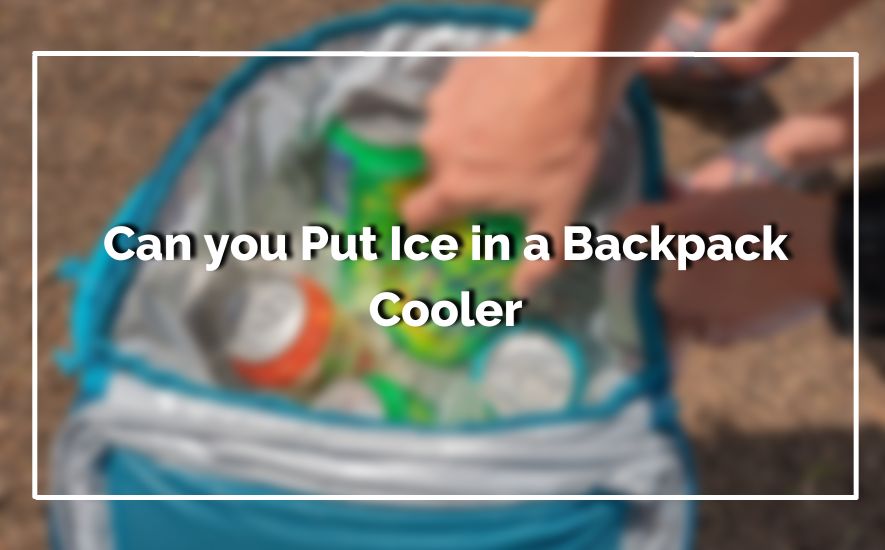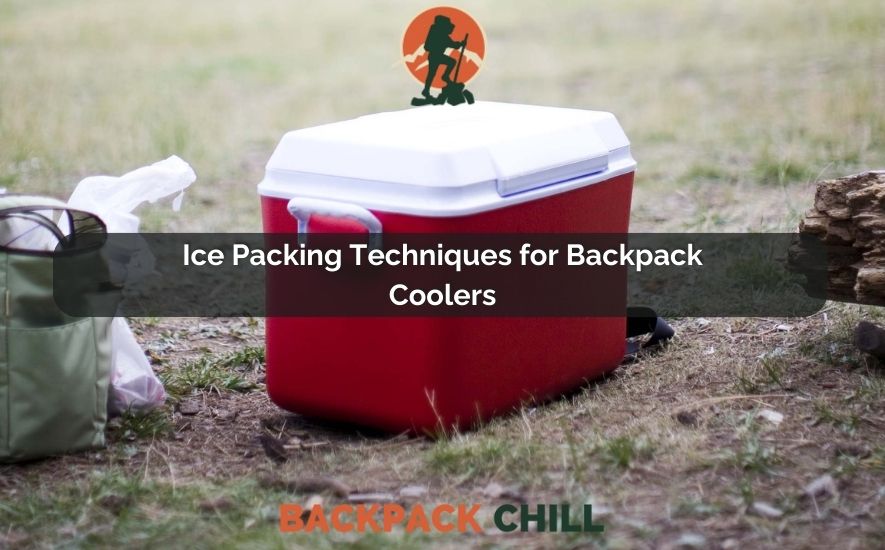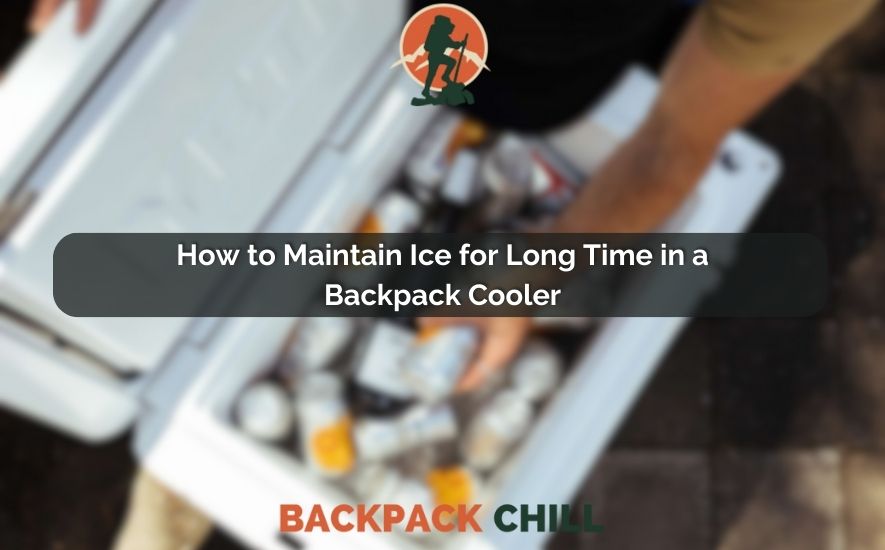Physical Address
304 North Cardinal St.
Dorchester Center, MA 02124
Physical Address
304 North Cardinal St.
Dorchester Center, MA 02124

When it comes to outdoor adventures or even everyday activities, having a trusty backpack cooler by your side can be a game-changer. Picture this: a hot summer day, a refreshing drink waiting for you, and the convenience of a backpack cooler to keep it cool and ready to quench your thirst. But here’s where the curiosity kicks in—can you put ice in a backpack cooler?
Can you Put Ice in a Backpack Cooler? Absolutely, you can put ice in a backpack cooler. However, it’s important to consider a few key factors to make the most of your cooling experience. The type of cooler, the quality of insulation, and the proper arrangement of ice packs all play a crucial role in maintaining the desired temperature for your perishables.
The answer lies in the delicate balance between practicality and functionality. As we delve into this question, we’ll explore the ins and outs of using ice in a backpack cooler, ensuring your on-the-go experiences remain refreshingly cool and hassle-free.
Placing ice inside your backpack cooler ensures that perishable items such as fruits, vegetables, and dairy products remain fresh and retain their nutritional value for a longer duration.
The cold temperature created by the ice helps slow down bacterial growth and enzymatic activity, extending the shelf life of your food and preventing spoilage. This allows you to enjoy crisp and delicious snacks even after several hours of exploration.
Ice acts as a natural temperature regulator, maintaining a consistent and cool environment within your backpack cooler. This controlled temperature is particularly beneficial when storing beverages like water, juices, and sodas.
By strategically placing ice packs alongside your drinks, you can relish refreshingly cold beverages throughout your adventure, quenching your thirst and providing relief from the outdoor heat.
The presence of ice in your backpack cooler opens up a world of culinary possibilities. From marinated meats for a sizzling barbecue to chilled salads and sandwiches, the cool environment powered by ice allows you to carry and enjoy a diverse range of meal options.
Imagine indulging in a scrumptious homemade pasta salad or a delectable yogurt parfait during your hike, all thanks to the cooling effects of ice.
Staying hydrated is essential for any outdoor activity, and adding ice to your backpack cooler can play a pivotal role in this.
By keeping a reserve of ice-cold water or electrolyte-rich drinks, you ensure that you have a refreshing and invigorating source of hydration readily available. The low temperature of the beverages can be especially rejuvenating after a rigorous trek or a spirited game of frisbee.
Ice serves as more than just a cooling element; it can come to the rescue in various situations. Injuries or strains can occur during outdoor escapades, and an ice pack from your backpack cooler can provide immediate relief and minimize swelling.
Additionally, melting ice can serve as a backup water source in emergencies or as a makeshift cold compress for various purposes, showcasing the versatility of this essential resource.

Optimal ice packing begins with a well-structured insulation strategy. Start by placing a layer of ice packs at the bottom of the cooler to create a foundation of cold.
On top of this, arrange a layer of perishables or drinks, followed by another layer of ice packs. This alternating pattern of ice packs and items creates an efficient temperature barrier, maintaining the cool environment inside the backpack cooler.
Enhance the effectiveness of your backpack cooler by pre-chilling your items before packing. Place beverages and perishables in your home refrigerator prior to your adventure.
This preemptive cooling reduces the strain on the ice packs and ensures a longer-lasting cold environment within the cooler. Remember, a well-chilled start leads to a longer-lasting cool experience.
While ice packs are convenient, large ice blocks can be more effective in sustaining a low temperature over an extended period. To incorporate ice blocks into your packing strategy, position them strategically within the cooler.
Place a few ice blocks in direct contact with the contents that need to stay the coldest, and then surround them with ice packs. This approach optimizes temperature distribution and maintains freshness.
Freeze packs and gel packs provide an innovative twist to traditional ice packing. These versatile cold sources can be molded to fit various spaces within the backpack cooler, filling gaps and optimizing thermal insulation. Place freeze or gel packs between items, filling any open spaces to minimize air circulation and maximize cooling efficiency.
To prevent cross-contamination and ensure even cooling, divide your backpack cooler into compartments using zippered pouches or containers. This approach helps maintain the integrity of delicate items and organizes your contents for easy access.
Separate drinks from perishables, and use smaller containers to store loose items, reducing the frequency of cooler opening and minimizing temperature fluctuations.
Ice packs are a timeless choice for cooling agents, and for good reason. They are easy to find, cost-effective, and reusable. Ice packs come in various sizes and shapes, allowing you to customize their arrangement in your backpack cooler for efficient cooling.
Their ability to maintain a low temperature for an extended period makes them suitable for longer outings. Plus, they don’t melt and create a mess like traditional ice, keeping your food and drinks dry and intact.
Gel packs offer a flexible cooling solution that conforms to the contours of your backpack cooler. Their pliable nature allows for optimal space utilization and even distribution of cold.
Gel packs are known for being leak-proof, preventing any potential mess inside your cooler. They also remain soft even when frozen, reducing the risk of damaging delicate items. Consider gel packs if you value convenience and versatility.
PCMs are a more advanced cooling option that utilizes the principle of phase change to maintain a consistent temperature. These materials absorb and release heat as they change from solid to liquid and vice versa.
PCMs are ideal for maintaining a specific temperature range, making them suitable for items that require precise cooling, such as medication or sensitive electronics. While they tend to be pricier, their long-lasting cooling effect and reliability make them a valuable investment.
For those seeking the utmost cooling power, dry ice is a remarkable choice. It maintains an incredibly low temperature and can keep your contents frozen for an extended period. However, handling dry ice requires caution, as it releases carbon dioxide gas as it sublimates.
Proper ventilation and safe handling are essential when using dry ice to avoid any risks. It’s recommended for situations where maintaining a frozen state is crucial, like transporting perishable items over long distances.
In recent years, technological advancements have introduced electronic cooling devices specifically designed for portable use. These devices use electricity or batteries to generate a cooling effect, offering precise temperature control.
They can be particularly beneficial for maintaining a chilled temperature in extreme heat conditions. While these solutions might be bulkier and more expensive, they provide efficient cooling performance and can be a game-changer for avid adventurers who require precise temperature regulation.

Before loading your backpack cooler, it’s wise to pre-cool it by storing it in a cool place or even the fridge for a few hours. This helps create an initial low-temperature environment that preserves ice longer.
When packing, organize your items with a clear separation between the ice and the contents you want to keep dry. Use ice packs or blocks, which melt more slowly than loose ice, and ensure they are thoroughly frozen before placement.
Strategic packing plays a significant role in ice retention. Begin by placing a layer of ice packs or blocks at the bottom of the cooler. These act as a solid foundation for your items. Then, position your perishables, beverages, and other items on top, leaving space for more ice packs between layers.
The goal is to minimize air gaps and maintain a consistent cold environment throughout the cooler.
Proper insulation is key to preventing heat transfer and ice melting. Utilize insulating materials such as towels or blankets to line the sides and top of the cooler, enhancing its cold retention capabilities.
Remember to keep the cooler closed as much as possible to prevent warm air from entering. Consider using a separate cooler for frequently accessed items to reduce the frequency of opening the main cooler.
While maintaining a consistently cold environment is important, it’s equally vital to monitor and regulate the internal temperature. To achieve this, limit exposing the cooler to direct sunlight or high temperatures.
Position it in shaded areas or under a picnic table. You can also use a thermometer to periodically check the temperature inside and adjust your packing and insulation accordingly.
As time passes, the ice will naturally begin to melt. To maximize its longevity, drain excess water from melted ice regularly. Keep spare frozen ice packs or blocks handy to replace the melting ones.
Ideally, you want to maintain a balance between preserving your chilled items and efficiently managing the ice to ensure optimal freshness throughout your outdoor excursion.
In summation, the question of whether ice can be placed within a backpack cooler hinges on the cooler’s design and purpose. While some coolers may accommodate ice without leakage, others might necessitate the use of ice packs to prevent dampness. It’s crucial to consider the specific cooler’s material and insulation capabilities, as well as its intended use, to make an informed decision.
Remember, tailoring your ice inclusion approach to your cooler’s unique features will ensure optimal performance and maintain the desired temperature for your on-the-go refreshments. Stay cool and make your adventures even cooler with the right backpack cooler strategy!
Absolutely, adding ice to your cooler bag is a smart move. It helps maintain the temperature and keeps your items cool for a longer time.
Whether you’re headed for a picnic, a day at the beach, or a road trip, ice acts as your trusty cooling companion. It prevents your food and drinks from spoiling and ensures they stay fresh and enjoyable. So, go ahead and pack that ice – your cooler bag will thank you!
Keeping ice in your cooler bag is a breeze. First, gather your items and place them inside the bag. Then, strategically position the ice packs or loose ice around them. You want to make sure there’s even coverage, so items stay uniformly cold.
If you’re using loose ice, consider using a barrier like a plastic bag to prevent direct contact and water accumulation. Also, try to limit opening the bag frequently, as this helps maintain the chilly environment inside.
The lifespan of ice in a cooler bag depends on several factors. The type and amount of ice you use, the quality of your cooler bag, and the external temperature all play a role.
Generally, well-insulated cooler bags can keep ice solid for about 24-48 hours. To extend this time, pre-chill your items, use larger ice packs, and keep your cooler bag out of direct sunlight. Remember, the colder you start, the longer your ice will last!
Absolutely, you can put ice in a cooler – that’s what it’s designed for! Ice helps regulate the temperature inside the cooler, ensuring your food and drinks remain cold and safe to consume.
Whether you’re on a camping adventure, tailgating, or simply having a picnic, ice in the cooler is your ally against heat. Just remember to pack your cooler smartly, distributing ice evenly and sealing the cooler properly to maximize its cooling potential.